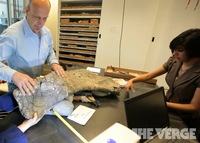 There’s a terrific article on The Verge describing all the details of actual Dinosaur printing. That’s the science of 3D scanning dinosaur fossils and using 3D printing technology to produce accurate replicas of the bones.
There’s a terrific article on The Verge describing all the details of actual Dinosaur printing. That’s the science of 3D scanning dinosaur fossils and using 3D printing technology to produce accurate replicas of the bones. Why do this? Why not just use the original bones? It turns out there are a number of benefits. First, the original bones can be left undisturbed while the replicas may be studied. Secondly, you can print many copies of the bone when only one original exists.
But there are deeper investigations that can be done. According to The Verge’s article, the Paleontology Department at Drexel University has been scanning their entire collection of fossils to create what might be the world’s largest digital dinosaur inventory. But then:
The Engineering department would then take those scans and use a 3D printer to create 1/10 scale models of the most important bones. But, he reported, that wouldn’t be the end of it: they intended, he said, to use those scale polymer “printouts” to model and then engineer fully working limbs, complete with musculature — to create, in effect, a fully accurate robotic dinosaur leg or arm, and eventually, a complete dinosaur.
You got that right: they’re not just printing dinosaur bones; they are trying to actually print a dinosaur!
Such interactive models would enable areas of study not easily done previously. When you can observe the entire limb moving, new conclusions can be drawn regarding the structure and position of the real animal.
Via The Verge


Being able to build exactly accurate scale models of dinosaurs would be a great education model! Can't wait to see this implemented!
Being able to build exactly accurate scale models of dinosaurs would be a great education model! Can't wait to see this implemented!